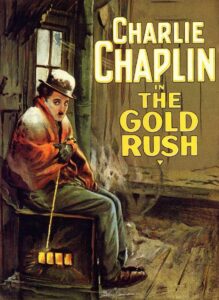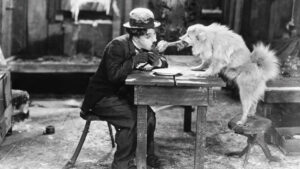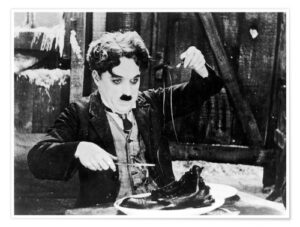“The Gold Rush” – a Bittersweet Film about the Search for Happiness

Title: “The Gold Rush”
Release Date: 1925
Director: Charlie Chaplin
Cast: Charlie Chaplin, Mack Swain, Tom Murray, Georgia Hale etc.
“The Gold Rush” is a comedy masterpiece in which Chaplin managed to combine comedy with a compelling love story. The film is based on the theme of gold prospecting in the late 19th century on the Klondike River in Canada. The main character, Tramp, ventures into the snow-capped Rocky Mountains, but unlike the crowds of travellers there, his goal is not to find some gold. The viewer is told that Tramp is looking for “no one knows what”. His otherness is apparent from the very beginning – for instance, the Tramp is not properly prepared for the journey, as he traverses the frigid peaks in his ordinary clothes, with an indispensable bamboo walking stick. The extreme hero’s inadequacy to the conditions of the journey is the source of the humour.
The Tramp accidentally ends up in the hut of a criminal wanted by the police, Larsen, but thanks to the unexpected appearance of a gold digger, Big Jim, he manages to avoid danger. Due to a snowstorm, the men are cut off from food, Larsen goes in search of food, and Tramp and Jim have to deal with hunger. When Jim gets the idea of devouring his companion, a meal in the form of a bear happily turns up. Later in the film, Tramp meets the beautiful Georgia, with whom he immediately falls in love. After many adventures, together with Big Jim, he discovers gold and as a millionaire finally wins the heart of the beloved woman.
“The Gold Rush” – playing with adventure film conventions
One of the essential dimensions of “The Gold Rush” is Chaplin’s play on the convention of adventure films. The plot is focused on the amusing adventures of the main character, but there is a constant surprise and unpredictability of events. The Tramp is walking with his characteristic duck step over a snowy mountain pass when suddenly a bear appears behind him. The animal follows the hero, but contrary to the viewer’s expectations it does not attack the man, but at some point turns aside. Another surprising motif is the scene in which Tramp is saved from suffocation at the last moment by the bear’s unexpected intrusion into the hut.

“The Gold Rush” – bravura gags and touching lyricism
“The Gold Rush” is teeming with masterfully won comic ideas. The Tramp himself, in his trademark costume: bowler hat, oversized shoes and pants, and bamboo cane, raises a smile. Chaplin constantly uses his physicality to make the audience laugh: he stumbles, falls over, and makes little awkwardnesses and mistakes. It is worth remembering that the gags from this film have gone down in cinema history. For example, we see the ingenious Tramp who, because of his hunger, prepares a meal from his own shoe and serves it to Jim and himself for dinner. With a gourmet look on his face, he eats a sole with nails sticking out of it and spaghetti made of shoelaces.
In another scene, when he has the honor of dancing with beautiful Georgia, it turns out that Charlie’s pants are too big. At first, the protagonist tries to save himself with his cane, holding the dressing table, and then he wraps himself with the cord he accidentally reached. Unluckily, there is a dog tied to the rope – it first dances playfully with the couple, and when it notices the cat, it unceremoniously knocks the embarrassed Tramp over. These scenes expose the extreme poverty of the protagonist, who tries to pose as an elegant gentleman but does not even have decent pants and shoes.
Other gags, on the other hand, emphasize Charlie’s incredible sensitivity and his artistic disposition. This is the case with the famous ballet of buns that the Tramp performs in his sleep on New Year’s Eve, when he is waiting for Georgia to arrive. The ridiculousness unexpectedly turns into emotion. For the Tramp’s character evokes sympathy – the film emphasizes his otherness and loneliness. The scene at the New Year’s Eve ball, when everyone is holding hands and singing the Farewell Waltz together, is vividly contrasted with the shot of a lonely Charlie sadly staring into the night. The Tramp’s cruel ridicule of the handsome and wealthy Pick-up Man also evokes emotion. He unceremoniously makes fun of the Tramp’s poverty and modest physical stature, and seeks to humiliate him by exploiting Charlie’s infatuation with Georgia.

“The Gold Rush” – the humanism of Chaplin’s everyman
“The Gold Rush” is a deeply humanistic film. The director touches upon the most universal problems of human existence in a comic convention. His protagonist is as funny as he is typical, an everyman with whom every viewer can identify. Through the Tramp’s touching adventures Chaplin establishes an intimate relationship with his audience. He shows a man who, despite obvious adversities, does not give up in his search for happiness. His low social status and lack of beauty do not rule out his chances in life.
It is significant that the characters in the film, in addition to their names, have general characteristics that assign them to a certain type. They are thus: The Tramp, The Gold-Digger, The Criminal or The Pick-up Man – characters that fit into allegorical poetics. Against this background, the image of Georgia is unique – she does not receive any superior attribution, which is of great importance for the film. Georgia is unique, one of a kind, Chaplin seems to be saying. Additionally, each appearance of the heroine in the film is preceded by an ornamental inscription with a floral motif in the background. This treatment emphasizes the director’s tender and intimate relationship with this character. It is love, and not the acquisition of fortune, that is the most important value for Tramp.
“The Gold Rush” – a Bittersweet Happy End
“The Gold Rush”, Chaplin’s best film, is one of the few works by the director to have a happy ending. The Tramp becomes a millionaire and is betrothed to the beautiful and sincerely loving Georgia. However, the film has an ironic undertone – finding happiness seems as impossible as the accidental discovery of gold by two prospectors lost in the mountains. Thus, the story of the pursuit of happiness becomes a narrative of its delusion. The achievement of the dream is like Charlie the Tramp’s dream: he thinks that Georgia shows up at the dinner he has prepared and kisses him tenderly, but in reality she is not there at all.
J. Guze, “Wśród bohaterów kina”, Warszawa 1983.
I. Sowińska, “Złoty wiek burleski”, [w:] “Kino nieme”, pod red. T. Lubelskiego, I. Sowińskiej i R. Syski, Kraków 2010.

